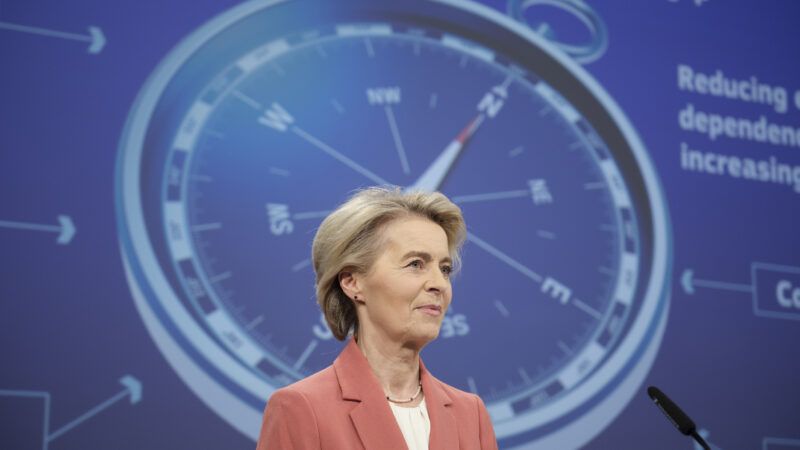The European Commission's (Anti)Competitiveness Compass
The European Union doesn’t need a five-year plan—it needs free markets.

The European Commission unveiled the Competitiveness Compass, a new initiative aimed at boosting member states' productivity, on Tuesday. European Commission President Ursula von der Leyen declared that the E.U. must adapt to a changing world to defend its values, but the Competitive Compass doubles down on central planning and aggressive environmental targets.
Despite its extensive integrated market, internally and internationally, the European Commission recognizes that the Union has "not kept pace with other major economies." In 2023, the Union's gross domestic product (GDP) per capita was $53,783 (in 2021 dollars), a level that the U.S. hasn't seen since 1999 and far less than U.S. GDP per capita of $74,578 in 2023. To provide more perspective, the European Commission praises a historically low unemployment rate of 6.1 percent in 2023; the American unemployment rate was nearly half that in the same year.
In its "Communication from the Commission," which details the policies that von der Leyer believes will make the E.U. more competitive, the Commission rightly identifies high energy prices and a high regulatory burden as making Europe's companies less competitive internationally. Nevertheless, it continues to double down on its ambitious climate goals. The Communication aims to create "a decarbonised economy by 2050" while reducing emissions by 90 percent by 2040.
The report also includes a "Clean Industrial Deal" that will provide subsidies for decarbonization while avoiding market distortions. (This is impossible—subsidies, by definition, are intended to change market behavior.) Meanwhile, the Commission calls for "technology neutrality" but, in the same paragraph, calls for "investing in recharging infrastructure and promoting uptake of electric vehicles."
The Competitiveness Compass gives lip service to deregulation, touting "the first-ever Commissioner for Implementation and Simplification…to identify ways to simplify, consolidate and codify legislation" and recommends reducing reporting burdens by "at least 25 percent for all companies." At the same time, the Commission doubles down on regulation, top-down dictates, and industrial policy, listing over 40 "acts," "directives," "frameworks," "guidelines," "initiatives," "packages," "pacts," "plans," "regulations," "reviews," "roadmaps," and "strategies," which direct public funds to industries and research the Commission believes will result in economic growth.
The Commission repeats it will use "public funding in a more focused and targeted way," but does not explain how it will do so. Unlike market actors who rely on price signals to determine how to most efficiently allocate private capital, the government lacks the proper incentives to make profitable investments. Moreover, subsidizing sectors promotes neither productive efficiency nor innovation; it perversely incentivizes firms to invest and produce suboptimally because they don't bear the full costs of doing so.
The Commission is similarly confused about the incentives involved in forced technology transfer. The Communication states that "pro-competitive technology licensing agreements [incentivize] initial [research and development], and [promote] innovation," but this is not so. A company has more incentive to make R&D investments when they are entitled to the exclusive use of their innovation, which allows them to differentiate their product from competitors and earn a profit.
To its credit, the Communication highlights how international trade agreements with Mexico and South American nations can increase the E.U.'s economic competitiveness. However, the majority of the plan increases the role and size of the public sector and is the wrong way to go. The European Commission should go back to the drawing board and create a plan that shrinks the size of government, reduces regulations, and increases economic freedom.


Show Comments (17)